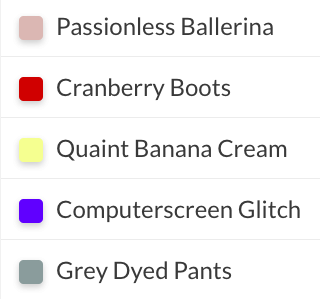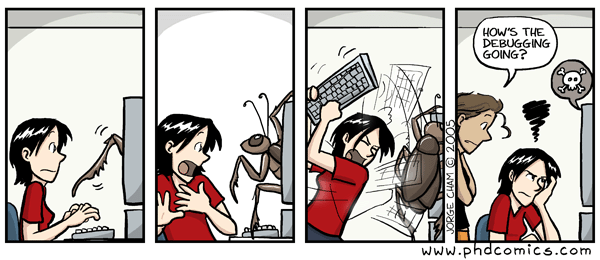
Due midnight, Wednesday Sept 29
Collaboration policy for COS 109: Working together to really understand the material in problem sets and labs is encouraged, but once you have things figured out, you must part company and compose your written answers independently. That helps you to be sure that you understand the material, and it obviates questions of whether the collaboration was too close.You must list any other class members with whom you collaborated.
Problem set answers need not be long, merely clear enough that we can understand what you have done, though for computational problems, show enough of your work that we can see where your answer came from. There is no need to repeat the question. Thanks.
And a couple of reminders...
If the
data you start with is approximate, the results cannot be precise.
Don't use Google or other search engines,
and don't use ChatGPT or similar generative AI programs.
You will learn a lot more if you do the work yourself.

(a) The site colornames.org is an entertaining attempt to crowd-source names for all of the 224 colors that are possible with 24 bits. Visit the site and name three previously unnamed colors and report the names and the hexadecimal values of your colors. (As of Sept 2024, only 23.5 percent of colors have been named. so you should have a lot of choice.)
(b) The standard RGB representation of colors uses 8 bits for the
red component, 8 bits for green, and 8 bits for blue (24 bits in all),
and thus 6 hexadecimal digits can express any given 24-bit color. For
instance, red is FF0000, green is 00FF00, blue is 0000FF, and yellow is
red plus green, or FFFF00. Suppose that a specialized display instead
devotes more bits to green (where the human eye is most sensitive): it
uses 7 bits for red, 11 bits for green and 6 bits for blue. Assuming
that the bits are stored left to right in RGB order, what are the
hexadecimal representations of red, green, blue, yellow, cyan and
magenta for this display?
Hint: draw a diagram of the 24 bits for a particular color, then
divide that into byte-sized chunks.
Again, do some practice with the practice problem generator. Don't use it to answer these questions, however -- if you do, how would you know whether you can answer such questions if by coincidence they were to appear on an exam?
(a) The population of the European Union is about 450 million. How many bits are required to store the population of the EU?
(b) How many bytes for the population?
(c) The population of USA is about 3/4 of the population of the EU. How many bytes would be required to store a number representing the population of the USA?
(d) How many bytes to store the combined population of the EU andd USA?
(e) The
US national debt
right now is over $35 trillion. How many bytes would be
required to store that number? [This site has more big numbers
than you would believe, some of which should worry you.]
"We still have judgment here; that we but teach(a) The 1946 paper Preliminary discussion of the logical design of an electronic computing instrument discusses an architectural tradeoff: whether to include an instruction for multiplication or to synthesize it by using the addition instruction. What section of the paper first raises this issue?
bloody instructions, which, being taught, return
to plague th' inventor."
(Macbeth, Act I, Scene VII.)
(b) The toy simulator (toysim.html) is a Javascript program running in a web page. The toy machine does not have a multiply instruction. Modify the simulator by adding a multiply instruction, with the instruction name mul. (The Javascript multiplication operator is *.) This requires a bit of detective work to find the places in the program where instructions are checked for validity and executed, then making changes that follow the existing pattern. Hint: look for handling of different operators like addition or subtraction to determine where to adjust the instruction.
Start by making your own copy of toysim.html, which you can do by control-clicking on the link and selecting "Save Link As..." in Firefox and Chrome, or "Save Linked File As..." in Safari. Use a text editor (as in Labs 1 and 2) to modify the HTML file, by adding just a handful of lines of code. Do not change the formatting of the original; follow the pattern of indentation that you see when you add your new lines.
Your answer should specify the additional code you wrote and tell where in the existing program you added it. Do not submit the whole program, but copy and paste your added code along with a couple of lines of the original that are on each side to show where you added it.
Here's an example of a program that uses mul to double each one of a sequence of input numbers, stopping when it reads a zero.
foo get
ifzero bar
mul 2
print
goto foo
bar stop
You can use this program to verify that your version implements mul
properly. Be sure you understand how it works.
We want you to write two short programs for the toy computer used in class. It's impossible to be sure that any program, even little ones like these, is correct without running it, so you must test your code and your understanding by using the toy simulator. Be careful about typographical conventions and the like, since the simulator is fragile. The code you submit should be cut and pasted from a working version.
Real programs are always developed incrementally. You may find it easier to start with something small and simple, like some of the programs in the notes or the one above, to be sure you understand how the simulator works and how to get numbers in and print them out again, before you try to solve the assigned problem. Then make sure you can get a number from the keyboard and print it back out and stop properly.
(a) Write a program that gets one number from the keyboard and prints its square and its cube. That is, if the original number is 10, the program prints 100 and 1000.) This should be about 7 instructions, and will use your mul instruction.
You will need to set aside a memory location to store a value. It's best to put that at the end of the program, or at least in a place where the simulator will not think it's an instruction.
(b) Write a program that gets one number from the keyboard, prints that number and every other number down to 0 inclusive in steps of 2, then stops. For instance, if the initial number is 6, the program prints 6, 4, 2, 0 on successive lines. If the initial number is 7, the program prints 7, 5, 3, 1.
This can be done in 5 instructions; it will not use mul and won't need a storage location. It doesn't matter how many instructions your solution takes, but if you find yourself writing a lot more, you're likely on the wrong track.
Hint: Think about the class example that adds up numbers. You might find it helpful to figure out the operations that have to be performed each time through the loop, then worry about how to start and stop the loop.
Either way, convert your answers to PDF and submit them by uploading a file called pset3.pdf to the "Pset3" assignment in Gradescope. You can submit as many times as you like; we'll only look at the last one.
